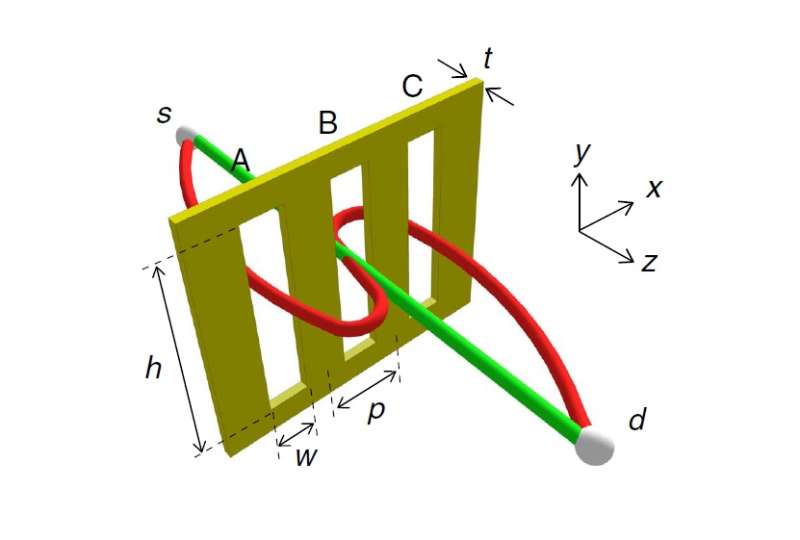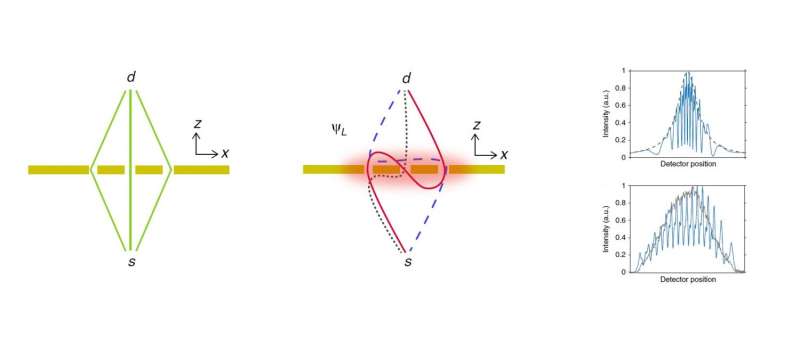January 6, 2017 feature
Physicists detect exotic looped trajectories of light in three-slit experiment

(Phys.org)—Physicists have performed a variation of the famous 200-year-old double-slit experiment that, for the first time, involves "exotic looped trajectories" of photons. These photons travel forward through one slit, then loop around and travel back through another slit, and then sometimes loop around again and travel forward through a third slit.
Interestingly, the contribution of these looped trajectories to the overall interference pattern leads to an apparent deviation from the usual form of the superposition principle. This apparent deviation can be understood as an incorrect application of the superposition principle—once the additional interference between looped and straight trajectories is accounted for, the superposition can be correctly applied.
The team of physicists, led by Omar S. Magaña-Loaiza and Israel De Leon, has published a paper on the new experiment in a recent issue of Nature Communications.
Loops of light
"Our work is the first experimental observation of looped trajectories," De Leon told Phys.org. "Looped trajectories are extremely difficult to detect because of their low probability of occurrence. Previously, researchers had suggested that these exotic trajectories could exist but failed to observe them."
To increase the probability of the occurrence of looped trajectories, the researchers designed a three-slit structure that supports surface plasmons, which the scientists describe as "strongly confined electromagnetic fields that can exist at the surface of metals." The presence of these electromagnetic fields near the three slits increases the contribution of looped trajectories to the overall interference pattern by almost two orders of magnitude.
"We provided a physical explanation that links the probability of these exotic trajectories to the near fields around the slits," De Leon said. "As such, one can increase the strength of near fields around the slits to increase the probability of photons following looped trajectories."
Superposition principle accounting for looped trajectories
The new three-slit experiment with looped trajectories is just one of many variations of the original double-slit experiment, first performed by Thomas Young in 1801. Since then, researchers have been performing versions that use electrons, atoms, or molecules instead of photons.
One of the reasons why the double-slit experiment has attracted so much attention is that it represents a physical manifestation of the principle of quantum superposition. The observation that individual particles can create an interference pattern implies that the particles must travel through both slits at the same time. This ability to occupy two places, or states, at once, is the defining feature of quantum superposition.

So far, all previous versions of the experiment have produced results that appear to be accurately described by the principle of superposition. This is because looped trajectories are so rare under normal conditions that their contribution to the overall interference pattern is typically negligible, and so applying the superposition principle to those cases results in a very good approximation.
It is when the contribution of the looped trajectories becomes non-negligible that it becomes apparent that the total interference is not simply the superposition of individual wavefunctions of photons with straight trajectories, and so the interference pattern is not correctly described by the usual form of the superposition principle.
Magaña-Loaiza explained this apparent deviation in more detail:
"The superposition principle is always valid—what is not valid is the inaccurate application of the superposition principle to a system with two or three slits," he said.
"For the past two centuries, scientists have assumed that one cannot observe interference if only one slit is illuminated in a two- or three-slit interferometer, and this is because this scenario represents the usual or typical case.
"However, in our paper we demonstrate that this is true only if the probability of photons to follow looped trajectories is negligible. Surprisingly, interference fringes are formed when photons following looped trajectories interfere with photons following straight (direct) trajectories, even when only one of the three slits is illuminated.
"The superposition principle can be applied to this surprising scenario by using the sum or 'superposition' of two wavefunctions; one describing a straight trajectory and the other describing looped trajectories. Not taking into account looped trajectories would represent an incorrect application of the superposition principle.
"To some extent, this effect is strange because scientists know that Thomas Young observed interference when he illuminated both slits and not only one. This is true only if the probability of photons following looped trajectories is negligible."
In addition to impacting physicists' understanding of the superposition principle as it is applied to these experiments, the results also reveal new properties of light that could have applications for quantum simulators and other technologies that rely on interference effects.
"We believe that exotic looped paths can have important implications in the study of decoherence mechanisms in interferometry or to increase the complexity of certain protocols for quantum random walks, quantum simulators, and other algorithms used in quantum computation," De Leon said.
More information: Omar S. Magaña-Loaiza, Israel De Leon et al. "Exotic looped trajectories of photons in three-slit interference." Nature Communications. DOI: 10.1038/ncomms13987
Journal information: Nature Communications
© 2017 Phys.org

















